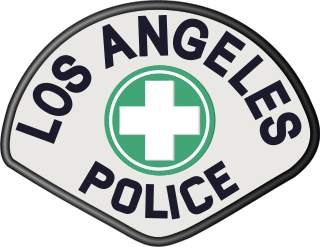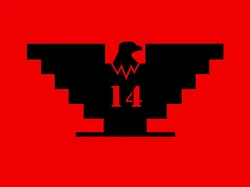
The Los Angeles Police Department (LAPD), officially known as the City of Los Angeles Police Department, is the primary law enforcement agency of Los Angeles, California, United States. With 8,967 officers and 3,000 civilian staff, it is the third-largest municipal police department in the United States, after the New York City Police Department and the Chicago Police Department.

Norteños are the various, affiliated gangs that pay tribute to Nuestra Familia while in California state and federal correctional facilities. Norteños may refer to Northern California as Norte Califas. Their biggest rivals are the Sureños from Southern California. As of 2008, the statewide north–south dividing line between Norteños and Sureños was regarded as running through the southern end of the Central Valley. The gang's membership consists primarily of Mexican Americans.

The Community Resources Against Street Hoodlums (CRASH) was a specialized gang intelligence unit of the Los Angeles Police Department (LAPD) tasked with combating gang-related crime between 1979 and 2000. The unit was established in the South Central district of Los Angeles, California, United States, to combat rising gang violence during the period. Each of the LAPD's 18 divisions had a CRASH unit assigned to it, whose primary goal was to suppress gang-related crimes in the city, which came about primarily from the increase in illegal drug trade.

The Mexican Mafia, also known as La eMe, is a Mexican American criminal organization in the United States. Despite its name, the Mexican Mafia did not originate in Mexico, and is entirely a U.S. criminal prison organization. Law enforcement officials report that the Mexican Mafia is the deadliest and most powerful gang within the California prison system.

The Rampart scandal was a police corruption scandal which unfolded in Los Angeles, California, United States, during the late 1990s and early 2000s. The scandal concerned widespread criminal activity within the Community Resources Against Street Hoodlums (CRASH) anti-gang unit of the Los Angeles Police Department's Rampart Division. More than 70 police officers were initially implicated in various forms of misconduct, including unprovoked shootings and beatings, planting of false evidence, stealing and dealing narcotics, bank robbery, perjury, and cover-ups thereof.
Venice 13 or West Side Venice 13, abbreviated as V13 or VX3, is a Mexican American street gang based in the Oakwood neighborhood of Venice, a section of Los Angeles, California. It has a substantial presence in East Venice as well as the Culver City/Los Angeles border, especially around Washington Blvd.

The Rampart Division of the Los Angeles Police Department (LAPD) serves communities to the west of Downtown Los Angeles (DTLA) including Silver Lake, Echo Park, Pico-Union and Westlake, all together designated as the Rampart patrol area. Its name is derived from Rampart Boulevard, one of the principal thoroughfares in its patrol area. The original station opened in 1966, located at 2710 West Temple Street. In 2008, the staff moved southeast to a newer facility located at 1401 West 6th Street. With 164,961 residents occupying a 5.4-square-mile (14 km2) area, Rampart is one of Los Angeles's most densely populated communities.
OVS is a Mexican American (Chicano) gang from Ontario, California.
Varrio Nuevo Estrada, also known as VNEx3, is a Chicano criminal street gang founded in Boyle Heights, California, in the Estrada Courts housing projects. VNE is one of 34 gangs in a 15-square-mile area east of downtown Los Angeles.
The Jungles faction of the Black P. Stones street gang is a division ("set") of the Bloods gang alliance in Los Angeles. Originating in Los Angeles' Baldwin Village neighborhood in the 1960s, the Black P. Stones became one of the largest gangs in the city. The gang has been linked to various crimes, including murders, assaults, robberies, narcotics violations and firearms violations, and has been the subject of numerous FBI and LAPD investigations.

The Los Angeles Police Department (LAPD) was formed in 1869, and has since become the third-largest law enforcement agency in the United States. They have been involved in various events in history, such as the Black Dahlia murder, the Watts riots, the 1992 Los Angeles riots, the North Hollywood shootout, the murder trial of O. J. Simpson, and the Rampart scandal.
Crime in Los Angeles has varied throughout time, reaching peaks between the 1970s and 1990s. Since the early 2020s, crime has increased in Los Angeles.

The Avenues, also known as Avenidas or AVE's, is a Mexican/Mexican American criminal street gang mostly in Los Angeles County, California. They originally started as a social club for local Latino youths to protect themselves from other violent youths. The Avenues, like most Mexican gangs in Los Angeles, are under the direct control of the Mexican Mafia when sent to State, County, or Federal prisons.

Toonerville Rifa 13, also known as The Ville, is a Mexican-American street gang located in Los Angeles county.

Sureños , also known as Southern United Raza, Sur 13 or Sureños X3, are groups of loosely affiliated gangs that pay tribute to the Mexican Mafia while in U.S. state and federal correctional facilities. Many Sureño gangs have rivalries with one another, and the only time this rivalry is set aside is when they enter the prison system. Thus, fighting is common among different Sureño gangs even though they share the same common identity. Sureños have emerged as a national gang in the United States.

Armenian Power 13, also known as AP, the Armenian Mob, or Armenian Mafia is an Armenian criminal organization and street gang founded and currently based in Los Angeles County, California. They are involved in drug trafficking, murder, assault, fraud, identity theft, illegal gambling, kidnapping, racketeering, robbery and extortion. They are believed to have around 200 members and hundreds of associates, according to the U.S. attorney’s office. They are also well known for their connections with the Mexican Mafia.

Playboys 13 Gang, also known by the acronym PBS13, is a predominantly Mexican-American street gang founded in the Los Angeles County, California and extends to areas in South Central Los Angeles and Orange County, California. The gang also goes by the Spanish term "Conejo" which means "rabbit" or Rabbit gang to identify itself. They align themselves with the prison gang known as La EME or the Mexican Mafia, Because of their affiliation with La EME, while in prison, they set aside their rivalry with other Southern California gang members known as Sureño.

Timothy Joseph McGhee is a convicted serial killer and Toonerville Rifa 13 gang member from the Atwater Village neighborhood of Los Angeles, California. He is alleged to be responsible for at least 12 homicides between 1997 and 2001, three of which led to convictions. McGhee is also suspected of at least ten attempted murders, four of which led to convictions. In 2018, the Los Angeles Times named McGhee one of the top 20 most notorious killers in the history of California, a list that included the likes of Charles Manson, the Golden State Killer, and the Night Stalker.
The Florencia 13, also known as South Side Florencia 13,Florence Gang, F13 is an American criminal street gang based in Los Angeles, California, composed mainly of Mexican-Americans. The gang is named after the Florence area of Los Angeles County, controlled by the Mexican Mafia. They are involved in drug smuggling, murder, assault and robbery.

The Mongols Motorcycle Club is considered a motorcycle gang by law enforcement and intelligence agencies in various countries internationally. Mongols members have a long history in the illegal drugs trade, money laundering, robbery, extortion, firearms violations, murder, and assault, among other crimes. However, senior Mongols members as well as attorneys for the club deny that the group as a whole is a criminal enterprise and claim that the Mongols' bylaws prohibit criminals and drug users from being members.












